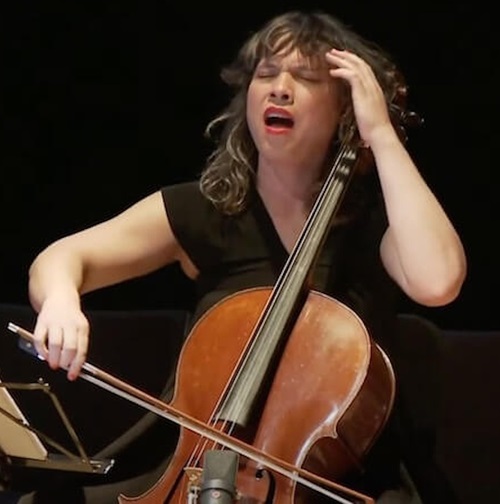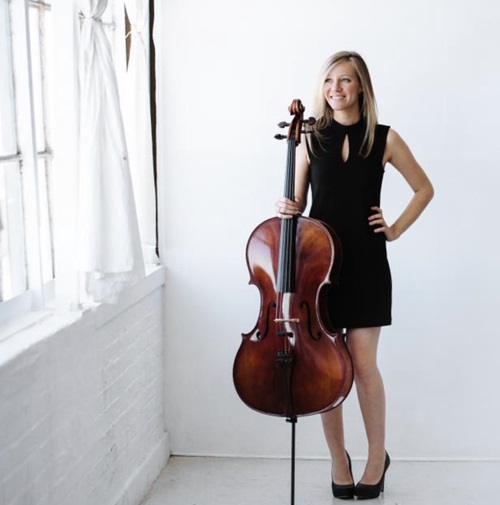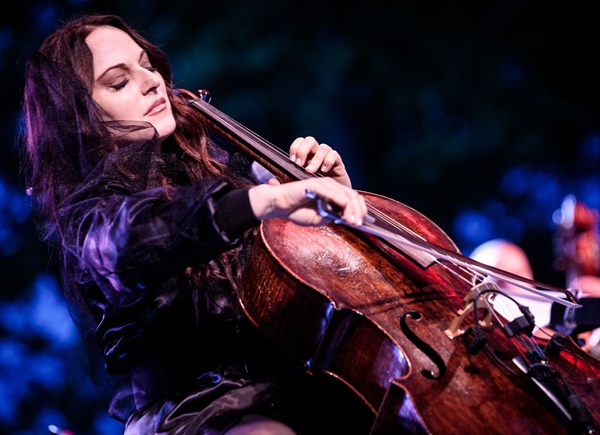At the Nimoy Theatre for CAP UCLA, Maya Beiser, Laura Metcalf, Christine Lamprea, Jeffrey Ziegler, and Andrew Zee prove the cello rivals the piano in recreating the Master’s work.
By John Lavitt
Los Angeles, CA (The Hollywood Times) 04-01-2024
Perhaps no modern composition is more suited for the piano than Philip Glass’s Complete Piano Etudes. While creating the etudes, Philip Glass tested and pushed his abilities to innovate on the instrument, seeing if he belonged in the vaulted tradition of the great composers. After seeing five masterful pianists take on the Complete Piano Etudes at the Walt Disney Concert Hall last week, I had trouble imagining such brilliant works being played by any other instrument. Working so well on the piano with its breadth and broad capabilities, how could any other instrument capture such complexity?
As one of the true adventurous rebels of modern classical music, Maya Beiser is never daunted when faced with a challenge. On Maya Beiser x Philip Glass, her fourteenth album, as expressed on her website, “Maya creates a multi-layered cello sound sculpture, unveiling new dimensions in some of Philip Glass’s most powerful and achingly beautiful works. Maya’s multi-cello arrangements include Glass’s Piano Etudes Nos. 2 and 5, Mad Rush, Music in Similar Motion, and selections from Naqoyqatsi, part of Glass’s Qatsi Trilogy with filmmaker Godfrey Reggio.”
Working live with four other accomplished cellists – Jeffrey Zeigler, Christine Lamprea, Andrew Yee, and Laura Metcalf – at the Nimoy Theatre, Maya Beiser led a performance to remember in the hallowed annals of the Center for the Art of Performance at UCLA (CAP UCLA). Stunning the audience with beauty and precision, the response to the performance was resoundingly positive. Indeed, there is no doubt that such innovation took the audience’s breath away.
When the five cellists took the stage at the Nimoy Theatre, you could not help but compare and contrast the instruments. The grain of the wood cries out like an individual to be examined and appreciated. Like each artist, each instrument has its feel and character. Seeing all five together from the outset, it was clear that something special was about to happen.
Maya Beiser took the center of the stage in black leather and platform shoes. With an alluring look, appearing like a cross between Morticia Addams, as played by Anjelica Houston, and Joan Jett in the early Blackheart days, she is charismatic. Moreover, her cello has a beautiful, vibrant chestnut grain that stands out like a rare find in a museum’s collection. When Maya Beiser and the four other cellists begin by diving right into Etude #5, perhaps the most beautiful composition in the Philip Glass catalog, you realize you better hold onto your seat and emotions because this will be a powerful night.
Doing justice to the work of Philip Glass in the new arrangements, the five cellos accentuate his brilliant use of repetition and memory. The audience cherishes each return as beautiful moments repeat themselves, as order battles entropy by accentuating memory. Like dueling acrobatics between the instruments, the complex repetitions give each arrangement a deeper meaning and an emotional impact. Behold the battling nature of mortality as composition and decomposition create an electrical tapestry of beauty that never lasts beyond the moment.

Discussing the brilliance of the new arrangements for the cellos, Maya Beiser explains, “I searched for layers of sound that might reveal something new about Glass’s ingenious creative power. I was thinking about stratum, the layering that occurs in most sedimentary rocks formed at the Earth’s surface. I imagined the layers of my cello becoming porous and Glass’s music flowing vociferously through each layer, like lava, endlessly creating new patterns, expanding into the landscape… In the live performance, I wanted to create a shared communal experience, to expand that powerful communion that enfolds between myself and the audience. I reached out to some of the most brilliant artists/cellists I know, wanting to create another communion between the five cellists performing. It’s a different kind of magic. It’s a dialogue that allows for multiple journeys to happen at once.”
Each of the five cellists did a remarkable job as part of the whole. A non-binary individual, Andrew Yee proved to be a hydrogen bomb ready to explode with incredible power and verve. They are like an Amazon warrior on the battlefield of classical music, giving everything they have with utter conviction. Although reserved at first, like a dutiful student in a classroom, Christine Lamprea exploded out of her shell. She plays with precision and a stunning passion.

At first glance, Laura Metcalf appears like an aristocratic blonde princess of a Greenwich mansion. However, she is the kind of artist such women long to emulate. Indeed, she plays with an unbending focus that places the music before any personal concerns. Her power is in the control of her artistry as she dedicates herself to the expression. As the sole man on stage, Jeffrey Zeigler also proved to be surprising. Taking on the most delicate and soft moments in the Glass compositions, he played with a compassionate artistry.
Finally, in the center of the storm like an eye gazing at the audience with her creative force, Maya Beiser led the way with an assurance that is pure and lovely to behold. One imagines no place in the world where she feels more comfortable than with a cello in her arms. Indeed, like Jimi Hendrix with his guitar or Georgia O’Keeffe with her canvases, the act of creation in her chosen expressive form gives her life meaning. She is one with her cello, and such a coming together needs to be experienced firsthand. If you cannot see her firsthand, purchase her new album on Apple Music – Maya Beiser x Philip Glass.
Photos Courtesy of the Cellists





